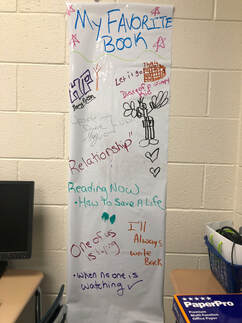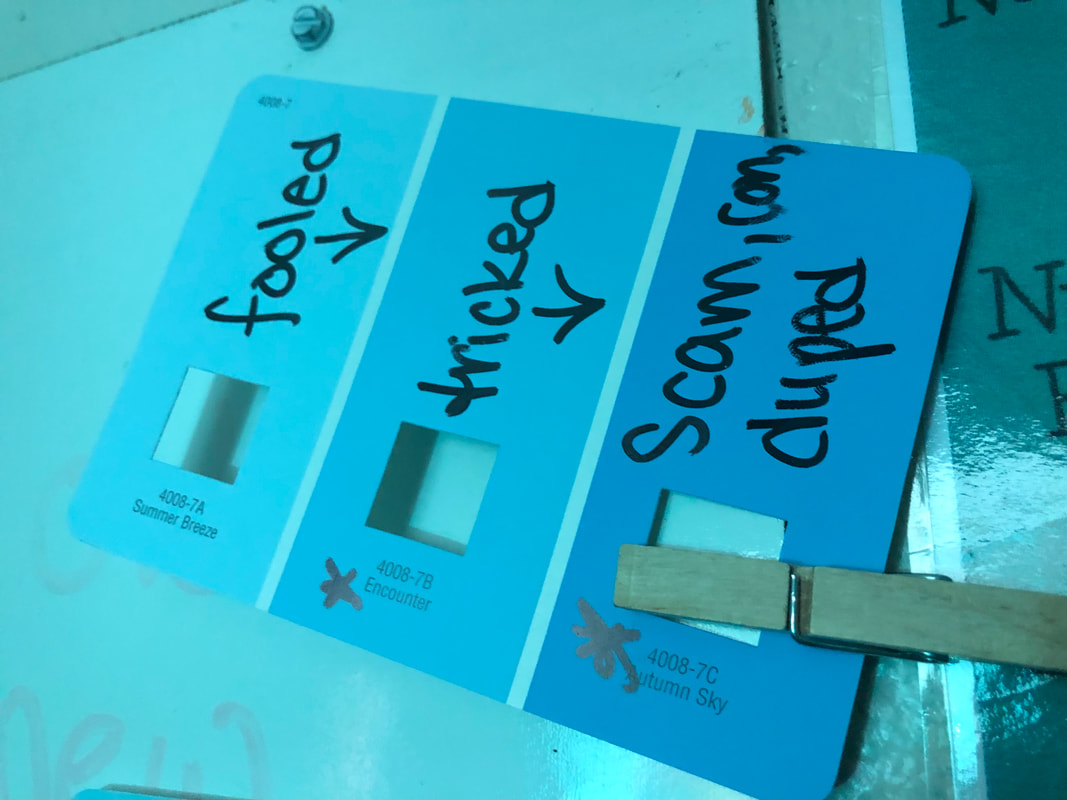|
I have been a teacher for 11 years now. I have my Master’s in Reading Education. Teaching literacy is a passion of mine. I get giddy going to Reading and Literacy workshops because I know I’ll leave with a new idea and strategy to take back to my classroom.
And since I became a mom, ideas for my son to do at home. In today’s blog, I will break down 5 literacy activities that I am doing right now in my classroom that you, as parents, can easily do in your own home. For each activity, I will list the materials needed and the age range for the activity. Spoiler alert: I teach deaf and hard-of-hearing students at the high school level. My students have a wide range of reading and language levels, but one thing that is all the same is that they ACTUALLY like these activities. I know, mouth wide open emoji. Teenagers actually liking something. #gross. But, they have asked me to do these activities each week. And that’s when you know you have a good literacy activity on your hand, folks. Lauren Barrett Writes is a participant in the Amazon Services LLC Associates Program, an affiliate advertising program. As an Amazon Associate, I earn from qualifying purchases. Read more about these links in my disclosure policy. So Without Further Ado….the 5 Literacy Activities
I saw this on Instagram from @thedimpledteacher and loved it. What is it? It is basically whiteboard sticky paper that you can place on the wall and use dry erase markers to scribble all over it. How am I using it? Kids love doodling and writing all over the board. I know I did when I was in school. Each month I have a topic or question displayed on the top, and students are invited to answer the question in the form of pictures, words, etc. They even can go up during free time to “graffiti” all over the paper. How to use it at home? Now, your little ones will be allowed to actually write all over the wall with this activity! Invite your kids to answer a question of the week or practice their ABCs or numbers. Or use the graffiti wall to do one of Busy Toddler’s activities or Days With Grey’s breakfast invitations. Or use it for kids to practice their spelling lists or hand writing. Or, or, or... Kids will like the novelty of “writing on the wall” and will be more willing to participate in whatever literacy activity you plan for them. Age Range? Any age!
2. Shades of Meaning
I first learned of this in a literacy workshop a few years ago. My students love this activity and hope your kids do as well. What is it? Find paint chip samples at any hardware store. I gather up a large variety of colors. Give your kids three words that mean roughly the same thing. How am I using it? They are going to reason through these three words and decide which has the strongest meaning and which has the weakest meaning. The word with the strongest meaning goes on the darkest shade, and the word with the weakest meaning goes on the lightest shade. For example, I will give my students the words ‘declare’, ‘say’, and ‘announce.’ My students will discuss in partners which one carries the strongest weight and makes more of an impact. Eventually, they determine that declare is the strongest word, announce goes in the meaning, and say is the weakest. I will ask for the train of thought and tell them that I agree with them. Finally, I will encourage them to use their strong words in writing and speech instead of always choosing weak words. How to use it at home? You can use it exactly as I use it or you can create your own spin to it. You can give your kids groups of three words, and they will have to rank which they like from least to best. Or smallest to largest. Or youngest to oldest. Or, or, or again. I would do this activity at the kitchen table or desk while you have to get something done but are still able to converse with them. Have your groups of three words and paint samples laid out on the table, explain the activity and model how to do one, and then go fix dinner or fold the laundry or heck even sit and sip coffee while they devour up this activity. Additionally, the paint chips make a cute decoration to your child’s room or playroom. I display mine around my classroom and it adds color and fun to the, otherwise, drab walls. Plus, they are a form of reference. Age Range? Kids should have the ability to read and copy down the words they see, so this could vary among kids. My suggestion is 6 and above.
3. Word Wall
I have been using a word wall in my classroom for 8 years now, and they have made a difference in my students’ vocabulary development. What is it? A display of talked about, important words that your students should know and remember. How am I using it? Our weekly vocabulary words, affixes, and idioms are displayed on the word wall for the whole year. Also, any word that we talk about that my students don’t know and that I deem important goes up on the word wall. Now, students have a frame of reference for these words. They can always see them, so the words are on the forefront of their minds. I also color code them, so the nouns are all one color, adjectives a different one, and the verbs a third color. How to use it at home? Anytime you talk about an important word in your family, put it up on the word wall (you can use the same paper for the graffiti wall). For your younger kids, you can have them print out a picture to go with the word. I would search Pinterest for different ways to display your word wall. But mine is just simple. Make sure your word wall is somewhere where your kids can see frequently. Age Range? Any age.
4. PQRST
P = prefix. QR = queen root. S = suffix. T=total. I am a big fan of morphology and derivation. To get into the nitty gritty of morphological analysis, you can read my case study that I did on it in grad school here. What is it? PQRST is the process of teaching kids that words have smaller bits of meaning in them. And knowing the meaning of these morphemes helps determine the overall meaning of a word. How am I using it? First, I teach a weekly prefix, suffix, or root weekly, so students who have had me for 4 years get approximately 80 affixes directly taught to them. And, of course, they are exposed to more indirectly. Second, I teach them the PQRST strategy through direct instruction and modeling. I teach them that a lot of words can be broken down into a prefix (p), queen root (qr), and suffix (s). After identifying those morphemes, they are taught to find the meaning of each. Lastly, they are taught to add those smaller definitions together to form one total (T) definition that makes sense in context. Students love practicing with PQRST and my enthusiasm for the matter makes them love it more. How to use it at home? I would use your large graffiti wall to draw the diagram for PQRST (see picture below). Together, you can search for words to break down together. Or this can be a breakfast invitation or something you set up when you need to get ready. Or this can be a weekly homework activity. Or, or, or. Your kids will love this especially if they are able to use the big whiteboard paper. Age Range? 7-8 and above.
5. Reading Chart
“Reading is to the mind as what exercise is to the body.” Get your kids reading. What is it? A reading chart is simple. It’s a list of books your students read. You can add extras to it if you like. How am I using it? Anytime my students read a book, they are to write it on a sheet of paper. Then, I have them answer some questions on a little piece of colored paper that I then display around the reading chart. The purpose is to highlight reading for pleasure with this no pressure activity. How to use it at home? I would use it the same way that I am doing. But maybe add some incentives. If your kids read so many books, they get something. I would also implement SSR (sustained silent reading) in your household. A time when your kids and you pick up a book and just read for 15-20 minutes. Set up a cozy reading corner and play soft music to set the mood. SSR is especially good for teenagers. Head to my website to see what I am reading or head to my teacher website to see the best books for teenagers. Age Range? You can do this at any age. But before your kids can read on their own, you will need to read the books to them and help them fill out the reading chart.
There you have it! 5 literacy activities you can try at home today. Just remember that literacy activities at home should be low pressure and fun. We don’t want our kids losing their love for reading.
Have fun!
0 Comments
Leave a Reply. |
Categories
All
|
Proudly powered by Weebly













 RSS Feed
RSS Feed